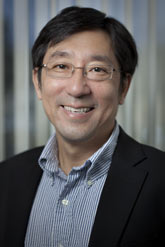

Friday - February 25, 2011
SLAC Today is
available online at:
http://today.slac.stanford.edu
In this issue:
From the Director of SSRL: Four Successful and Productive Reviews
Word of the Week: Diffraction Pattern
 |
 |
|
Friday - February 25, 2011 |
From the Director of SSRL: Four Successful and Productive Reviews Over the last few months, we at the Stanford Synchrotron Radiation Lightsource have been quite busy. In addition to keeping the accelerator and beamlines operating well for the users, we prepared and hosted the SSRL Scientific Advisory Committee meeting on January 10-11, the SSRL Machine Advisory Committee meeting on January 12, the SSRL Users' Executive Committee meeting on January 27, the Department of Energy tri-annual review of SSRL on February 9-11, and the SSRL Proposal Review Panel meeting on February 18. It's been a whirlwind, but a very productive and useful one. The first meeting brought together the Scientific Advisory Committee, which advises SSRL and SLAC on the long- term scientific direction, utilization and scientific productivity of SSRL. We have significantly expanded the SAC membership to provide better coverage in priority scientific areas and facility management. We are also looking to the SAC to help facilitate the formation of strategic alliances with entities such as DOE Innovation Hubs. At the meeting, we presented an update on recent progress and changes at SSRL, as well as an overview of SSRL for the benefit of new committee members. And, most importantly, we presented the current status of the SSRL strategic plan and our vision for its development. In the coming months, we will work closely with the SAC to complete the plan. As part of the SSRL strategy, it is critically important to operate SPEAR3 reliably for users and to clearly define an improvement plan to keep SPEAR3 competitive for the next decade and beyond. The Machine Advisory Committee was charged with reviewing and providing feedback on the accelerator improvement plan developed by the accelerator staff. The committee report will be discussed at the next meeting of the Science Advisory Committee, which will provide input on the prioritization of accelerator upgrades and their relevance to the scientific programs. Read more... X-ray diffraction pattern of a single
Mimivirus particle imaged at the LCLS. (Image: Tomas Ekeberg, Uppsala University.)
Word of the Week: Diffraction PatternAny kind of wave—be it light, sound or ocean—appears to bend or diffract as it passes an obstacle. A wave passing multiple objects diffracts into curving ripples that may collide. When the peak of one ripple meets the trough of another, they cancel each other; when peaks collide with peaks, they join to become larger crests. The resulting interference pattern can reveal the shape and size of the obstacles encountered. In X-ray diffraction studies, those obstacles are molecules within a sample material. The way they bend passing light, shown in diffraction patterns like the one above, reveals their structure. The smaller the wavelength of light used, the finer the detail that can be seen. Recent experiments at the Linac Coherent Light Source used the X-ray laser's extremely bright, short-wavelength pulses to image tiny biological structures and capture unusually fine, crisp diffraction patterns. |
Events
Access
AnnouncementsLab AnnouncementsCommunity Bulletin BoardTrainingLab Training
Upcoming Workshops & Classes
News
|
|
| | ||
|
|
||
 <%
Response.AddHeader "Last-modified", getArticleDate()
'Response.AddHeader "Last-modified","Mon, 01 Sep 1997 01:03:33 GMT"
'Monday, December 06, 2010
%>
<%
Response.AddHeader "Last-modified", getArticleDate()
'Response.AddHeader "Last-modified","Mon, 01 Sep 1997 01:03:33 GMT"
'Monday, December 06, 2010
%>View online at http://today.slac.stanford.edu/. |
||